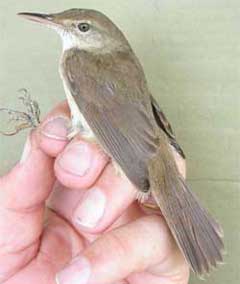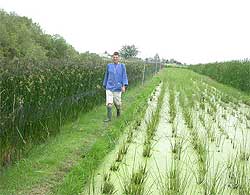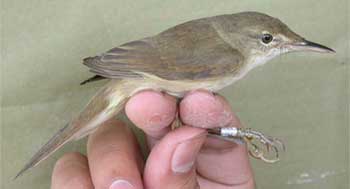|
|
| News |
| |
| |
Rediscovery of Large-billed
Reed Warbler Acrocephalus
orinus 139 years after
the capture of the only previously known specimen
 Large-billed
Reed Warbler
Large-billed
Reed Warbler
Acrocephalus orinus
(Photo by Philip D. Round) |
|
Compelling
evidence has been released of the continuing
existence of the Large-billed Reed Warbler
Acrocephalus orinus, previously
known only from the unique type specimen
collected in NW India 139 years ago.
This
small, unstreaked Acrocephalus
warbler (pictured left) was caught during
routine monitoring and ringing of migratory
birds in conjunction with the Wildlife Research
Division of the Department of National Parks
and the royally initiated Laem
Pak Bia Environmental Research and Development
Project, Phetchaburi Province, SW Thailand,
approximately 3,100 km from the type locality,
on 27 March 2006.
The
type specimen of A. orinus was
recently re-examined (Bensch and Pearson
2002), confirming its status as a bona-fide
species. Morphological and genetic analyses
of the Laem Pak Bia bird confirmed its identity
as A. orinus, and revealed that
there was sufficient genetic variation to
indicate the continued existence of a viable
population of the species. |
Whilst
this species is an addition to the Thai list,
where the population might breed or winter is
still unknown. This, just the second record ever,
does not throw much light on where A. orinus
might normally be found. The fact that both records
occurred in the northern hemisphere's winter period
and that the closest relative, Blyth's Reed Warbler
A. dumetorum, winters in southern Asia, it
is thought that A. Orinus probably breeds
somewhere in the Palaearctic, wintering in southern
Asia, most likely to the west of Thailand, possibly
in Myanmar or the Indian subcontinent. It is quite
possible that it could winter alongside Blunt-winged
Warbler A. concinens, or A. dumetorum,
but has remained undetected due to its close similarity
to these species in the field. |
|
|
| |
The location of capture at Laem
Pak Bia is a small area of grass filter
beds in a royally initiated wastewater treatment
project in Phetchaburi Province, Thailand.
It is located in an area of otherwise brackish
water, in which the dominant land-use is
salt pans, and separated from the coast
by a 500 m-wide belt of regenerating mangroves.
Most of the wastewater treatment project
consists of five large water treatment ponds
which lack fringing vegetation.
From
2000-2006
approximately 200 individuals each of Black-browed
and Oriental Reed Warbler have been caught.and
ringed, with A. orinus being the
only other Acrocephalus warbler
having been encountered. |
|

Location
of Capture |
|
|
|
| |
 Large-billed
Reed Warbler Acrocephalus orinus
Large-billed
Reed Warbler Acrocephalus orinus
(Photo by Philip D. Round) |
|
100 kilometres further south, extensive
ringing of Acrocephalus warblers
has been carried out in the Phragmites
reedswamp at Khao Sam Roi Yot, yet A.
orinus has never been recorded there.
These
facts perhaps
indicate that the core habitat of A.
orinus is something other than Phragmites,
and certainly suggest that it is an extreme
vagrant specifically to this region and
probably to Thailand in general. |
|
|
|
| |
Since this amazing rediscovery, another specimen
has been confirmed, using DNA analysis, from a
collection in Tring, UK. Read more
Birdlife
International.
More
photographs and details of the rediscovery of
Large-billed Reed warbler as well as comparison
with simialr species on the BCST
website.
| |
|
This
article was compiled using information from
Round et al. (2007). Lost
and found: the enigmatic large-billed reed
warbler Acrocephalus orinus rediscovered
after 139 years, Journal of Avian Biology
38, pp 133-138 (March
2007) kindly sent to me by Philip
D. Round. |
Related
pages: Laem
Pak Bia/Pak Thale , Laem
Pak Bia/Pak Thale Checklist , Additions
to Thai Checklist
.
|
|
|
|
|

Visitors
since 01/09/06

|
Updating
& developing thaibirding.com can be time consuming.
If you have benefited from the information here and would
like to make a donation through my paypal account, I would
be extremely grateful. 10% of any moneymade through this
website will be used for bird conservation in Thailand.
|
Home
: Site map : Contributors

|
|
|

Copyright
© 2004-2007 thaibirding.com. All rights reserved. |

